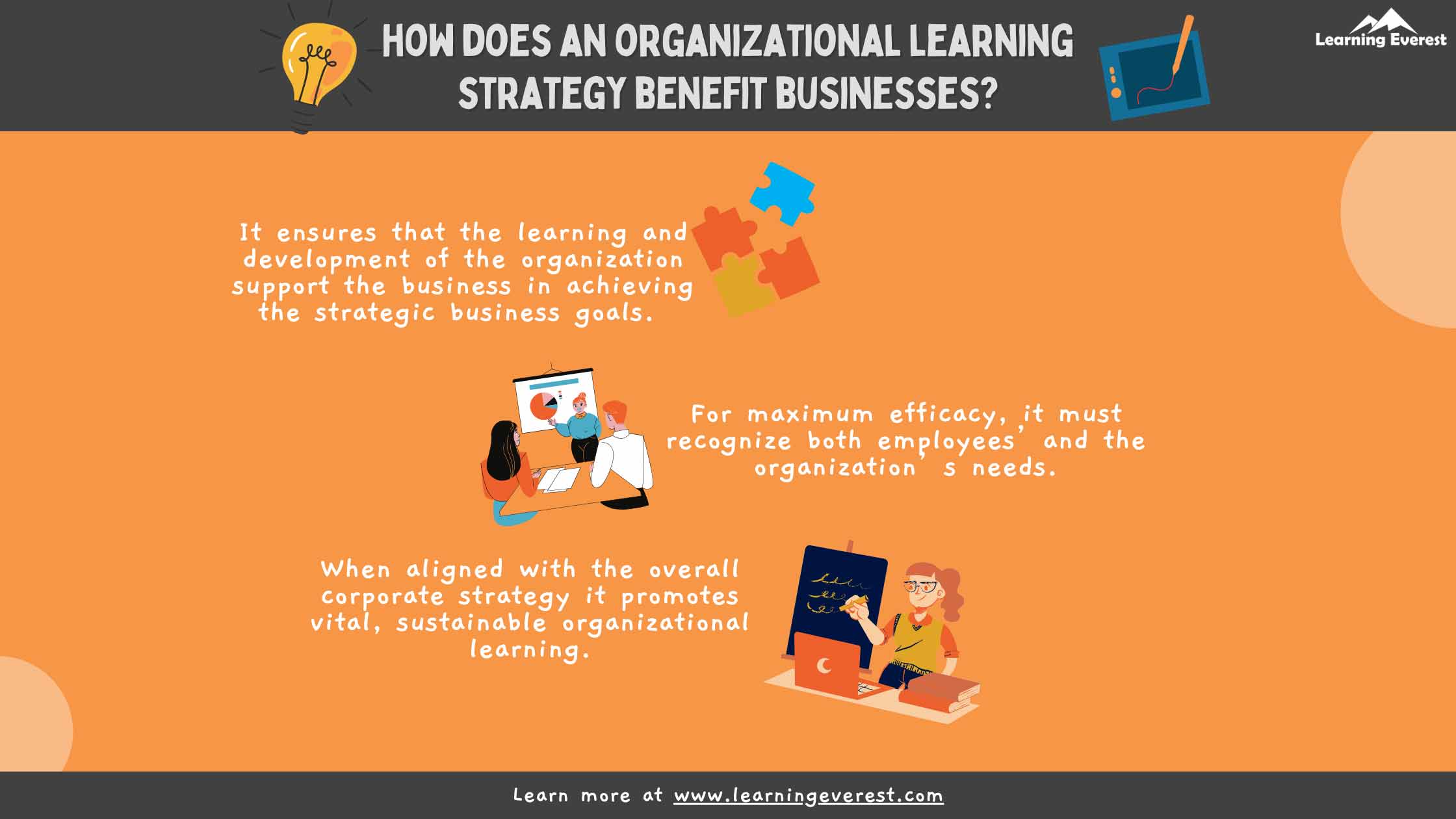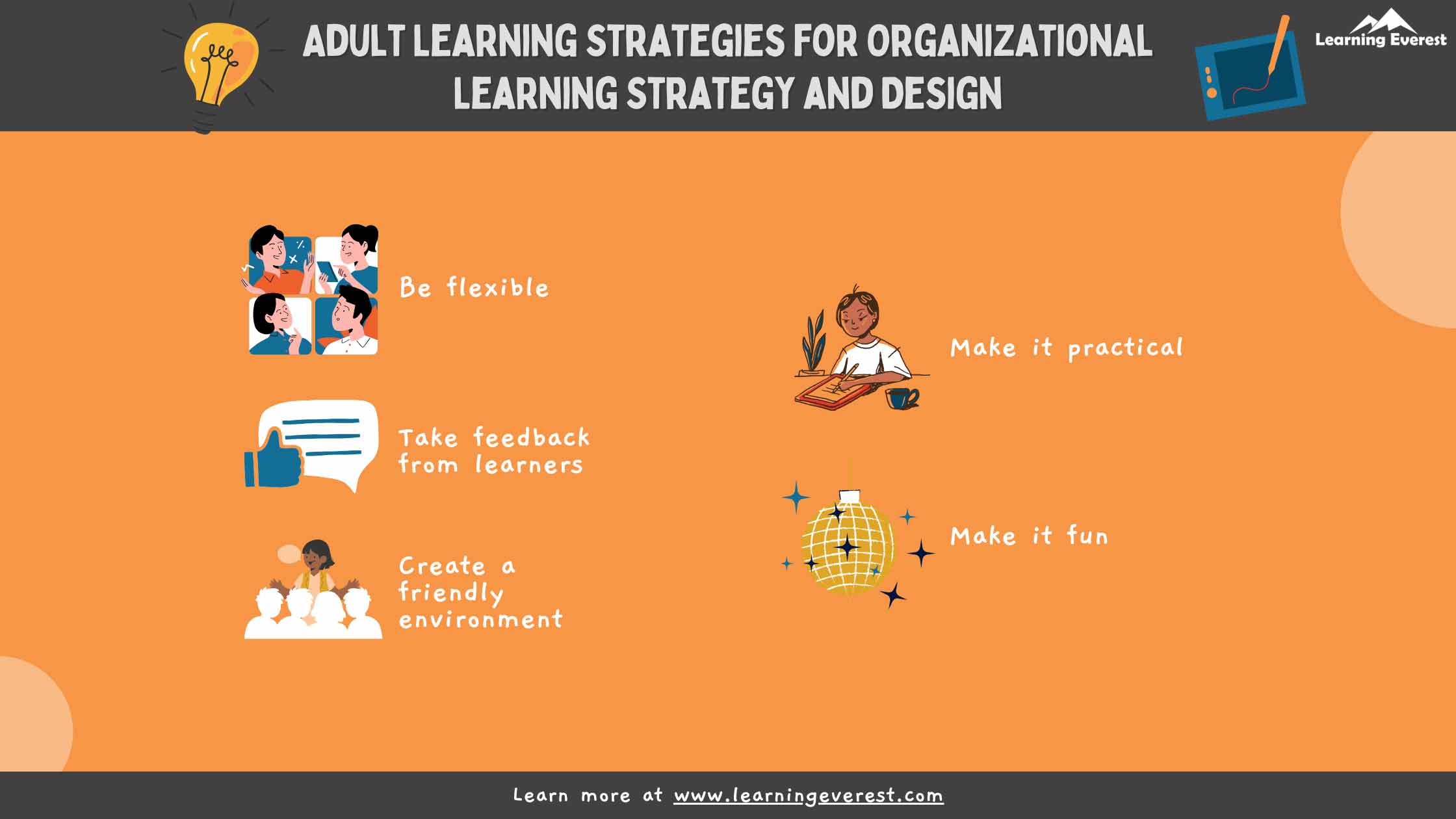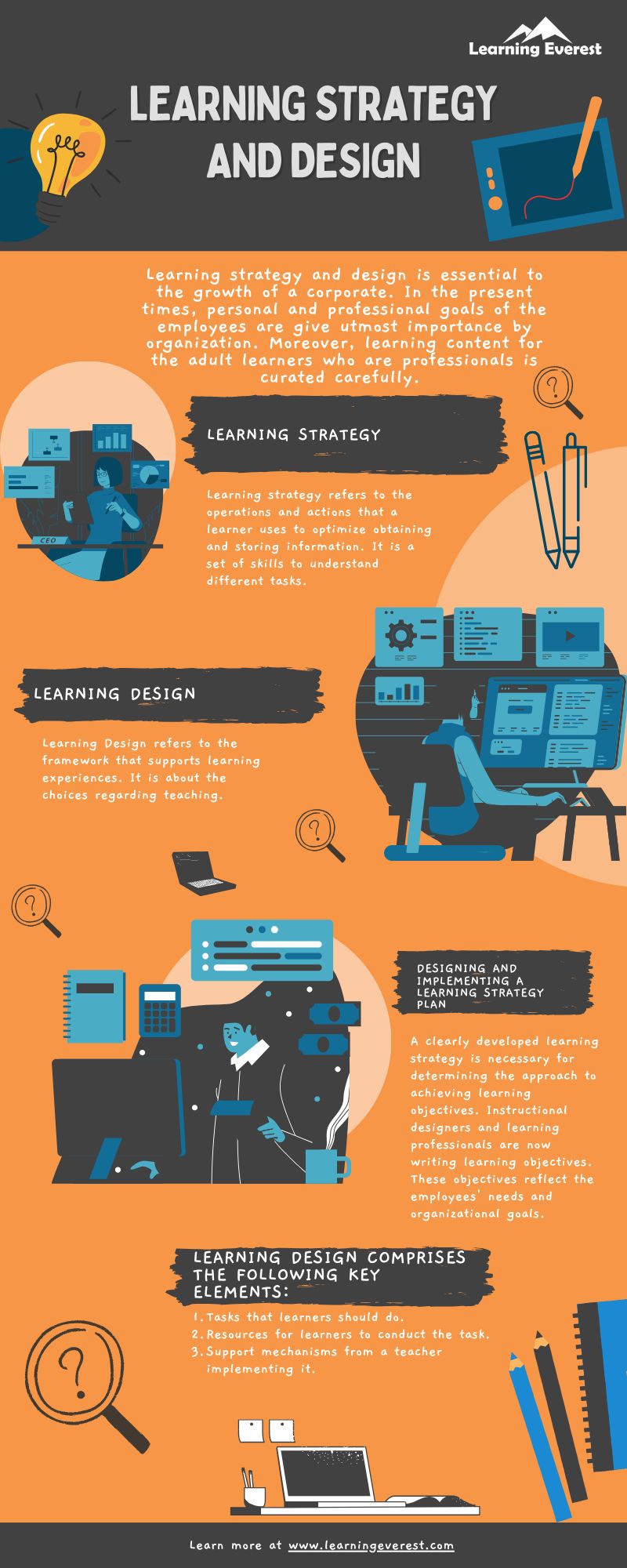Learning strategy and design is essential to the growth of a organization. In the present times, the employees' personal and professional goals are given utmost importance by the organization. Moreover, learning content for adult learners who are professionals is curated carefully. Organizations have L&D teams to take care of employee training. It is where learning strategy and design come in to picture. In this article, you will find more about learning strategies. You will also find out what makes a good learning design.
Table of Contents
What is Learning Strategy and Design?
Learning Strategy
Learning strategy refers to the operations and actions that a learner uses to optimize obtaining and storing information. It is a set of skills to understand different tasks. Thus, the learner can choose and effectively employ the appropriate technique to accomplish tasks or meet specific learning goals.
An organizational learning strategy ensures that the learning and development of the organization support the business in achieving the strategic business goals. The learning strategy must recognize both employees’ individual and the company’s needs. It must align with the overall corporate strategy to promote vital, sustainable organizational learning.

How Does an Organizational Learning Strategy Benefit Businesses
Learning Design
Learning Design refers to the framework that supports learning experiences. It is about the choices regarding teaching. Decisions about the content, structure, pedagogical strategies, order of learning activities, course assessment, and the technology used to support learning come under this.
Designing and Implementing a Learning Strategy Plan
A clearly developed learning strategy is necessary for determining the approach to achieving learning objectives. Instructional designers and learning professionals are now writing learning objectives. These objectives reflect the employees’ needs and organizational goals. There are several methods to achieve learning objectives. However, a well-defined learning strategy is essential to achieve the learning objectives.
What is a well-defined learning strategy?
A well-defined learning strategy plan should align specific components to achieve the organization’s goals. There the following steps must be taken:
- Identify the method to implement the learning strategy.
- Ensure you understand the organization and audience well.
- The selected learning methods, principles, and models should be repeatable.
- They must be based on reliable information. Thus, there is consistency.
- Analyze the goals of your organization and ensure that the method to implement the learning strategy aligns with the organizational needs.
- Verify that your measures, information, and improvement systems are complementary across departments.
- Validate the learning strategy plans, processes, results, analyses, learning, and actions are harmonized across teams to support organization-wide goals.
- Measure and evaluate the indicators of performance improvements or the sustainability of good performance. Make sure that your results:
- Shows improvement
- Demonstrate the accomplishment of an action plan to address a performance requirement identified during the approach phase
- Shows alignment between organizational goals, learning objectives, and stakeholders’ expected outcomes.
To identify the method to implement the learning strategy, you must do the following things:
- the needs of your employees
- Discuss with subject matter experts
- Determine if the learning solution must address the skills and knowledge or performance improvement solution
Implementing the learning strategy plan
The following steps are involved in implementing a learning strategy:
- Develop the training material
- Define strategic moments for the use of social media and informal learning initiatives
- Implement evaluation tools to measure the learning strategy
A learning strategy plan should focus on two kinds of learning: organizational and personal. A workplace learning and performance professional should be responsible for valuing the people in his workforce by committing to their engagement, satisfaction, development, and well-being. Increasingly, this involves more flexible, high-performance solutions customized to varying workplace and learners’ needs.
Organizational Learning Strategy
Organizational learning strategy enables organizations to learn, improve, and develop new capabilities. Let’s look at all you need to know about creating an organizational learning strategy.
What is organizational learning?
In an organization, learning is the process of building and transmitting knowledge within—this knowledge transmission results in knowledge creation, retention, and transfer.
What is an organizational learning strategy?
An organizational learning strategy provides a solid framework to the teams in contributing to the company’s overall strategic goals. An organizational learning strategy explains what will make learning effective in an organization, how business understandings can be shared and created, who is responsible for developing and sharing the learners. Without a detailed learning strategy, an organization can lose its direction.
A solid organizational learning strategy will:
- Ensure competitiveness in the changing business environment.
- Ensure that employees are constantly creating, retaining, and transferring knowledge.
- Ensure that the company is flexible to survive over time.
- It helps to increase productivity and profitability
- Promotes innovation to allow the business to reach its full potential
Creating an effective organizational learning strategy
- The organizational learning strategy must align with your business strategy: The organizational learning strategy must align with your company’s strategic objectives. When you have a business goal, the learning strategy must help the team achieve that goal. Business units, human resources, and L&D departments must closely collaborate when creating a strategy for organizational learning.
- Integrate organizational learning into your organization’s culture: If organizational learning is part of your organization, you can hire and retain employees who learn, improve, and innovate. Create a culture of learning. If you have a solid talent development program, your employees and teams will develop strategic new skills, competencies, and behaviors effectively.
- Facilitate experimenting: Experimentation is all about learning. Ideas may fail, but failure is vital to understanding. Without falling, you cannot learn what you could do better.
- Work on your knowledge management: It is essential to build knowledge as an organization. Ensure that the learning doesn’t disappear when an employee leaves. Implement knowledge retention through visuals and videos, documentation, or with the L&D team. There are internal knowledge databases in organizations that can be set up to retain and transfer knowledge.
- Promote collaboration: Promote collaboration through cross-team meetings or brainstorming sessions. These sessions can create a knowledge-sharing mindset among your employees.
- Measure the progress: Track how creation, retention, and transfer of knowledge happens in your organization.
Most organizations need to create educational strategies for two types:
- Education for new hires
- Education for employees
A corporate-wide learning strategy aims for its employees to perform their jobs and fulfill their responsibilities to the best of their ability.
Education for new hires
New hires must learn the following:
- The history of the organization
- How the organization conducts business
- How to interact with fellow employees
Education for employees
The corporate learning strategy depends on the type of corporation. In specific fields, employees must attend a certain amount of hours of training in their discipline each year to retain their certifications. Other in-house educational programs include activities on computer applications. These applications can be both job-specific and office applications.
Adult learning strategies
The following are learning strategies that will help adults learn:
- Flexible Learning Experience: Adult learners are from different life stages and have different viewpoints and values. Allow learners to choose the course’s pace, method, content, or assessment.
- Ask for Feedback: Provide learners with a chance to contribute to their learning experience. Ask them what they feel about
- Create a friendly environment: Create a comfortable learning space. Learners must feel free to respond to questions. When the answer given by a learner is incorrect, use them as an opportunity to allow the learner to learn from mistakes. They always feel safe, respected, and encouraged.
- Learning must be Practical: Use a how-to approach. These approaches cover only one topic at a time.
- Make It Fun: Adult learners engaged in fun learning environments are more motivated to learn. Keep your course content fresh and exciting, yet incorporate some mystery, too.

Adult Learning Strategies for Organizational Learning Strategy and Design
The Strategic Role of L&D in an Organization
The following are the five areas that come under the strategic role of L&D teams:
- Hire and retain professionals are in charge of their personal and professional growth.
- Employees must be supplemented by new learning and relevant work experiences.
- L&D should build a values-based culture and a sense of community.
- Communicate the brand strength explicitly through an employer value proposition.
- Provide employees an opportunity to learn and develop new competencies. Motivate and encourage them.
How to develop an effective strategy
- Determine what education does the new hires need
- Determine what education does the long-term employees need
- Choose the best way to deliver the training program.
- Ensure that training programs are offered for management and all the employees.
- Find a strategy to measure the success of all educational programs.
- Create a space for communication between the instructor and the learner.
Learning Design
Learning design is a sequence of activities and interactions that supports student learning experiences.
Learning design comprises the following key elements:
- Tasks that learners should do.
- Resources for learners to conduct the task.
- Support mechanisms from a teacher implementing it.
Steps for good learning design
- Document your organizational goals and drivers. The goal for each training organization is different. Therefore, define the learning goal to create a plan to achieve this.
- Training providers work with organizations to identify opportunities or challenges in your market. These are unique to each training business. Find them out.
- Organizations know about their target audience. L&D teams can work on understanding them better with surveys and discovery sessions.
- Work on the learning topics that your organization should offer.
- Review your organization’s current learning offerings. This review must be done in the context of your goals and best practice.
- Create a report to summarize the findings you have made. Choose the design relevant to your content and audience.
- You may have to convert some of your existing course content.
- Learning designers can create new projects to develop learning for a new topic. Their responsibilities include storyboarding, designing, building, and delivering the module.
Infographics
Knowledge Check!
Frequently Asked Questions (FAQs)
What is a corporate learning strategy?
The corporate learning strategy ensures that all employees can perform their jobs to their best ability. It is part of an employee retention plan. The corporate learning strategy should provide services and resources to its users efficiently. The organization must have resources to support the objectives of the corporate learning strategy.
What is a learning design strategy?
An instructional design strategy is to how a particular subject will be taught. It is the detailed plan for the designing of an eLearning course. It consists of the methods, techniques, and devices used to instruct learners
How do you develop a learning strategy?
- Identify the method to implement the learning strategy.
- Ensure you understand the organization and audience well.
- Analyze your organization’s goals and ensure that the method to implement the learning strategy aligns with the organizational needs.
- Verify that your measures, information, and improvement systems complement departments.
- Validate the learning strategy plans, processes, results, analyses, learning, and actions are harmonized across teams to support organization-wide goals.
- Measure and evaluate the indicators of performance improvements or the sustainability of good performance.
What is learning strategy training?
Learning strategy refers to an individual using a particular set of skills to learn content more effectively and efficiently. It concentrates on strategies that facilitate the active learning process. It teaches the learners how to learn and use what they have learned to solve problems and be successful.







